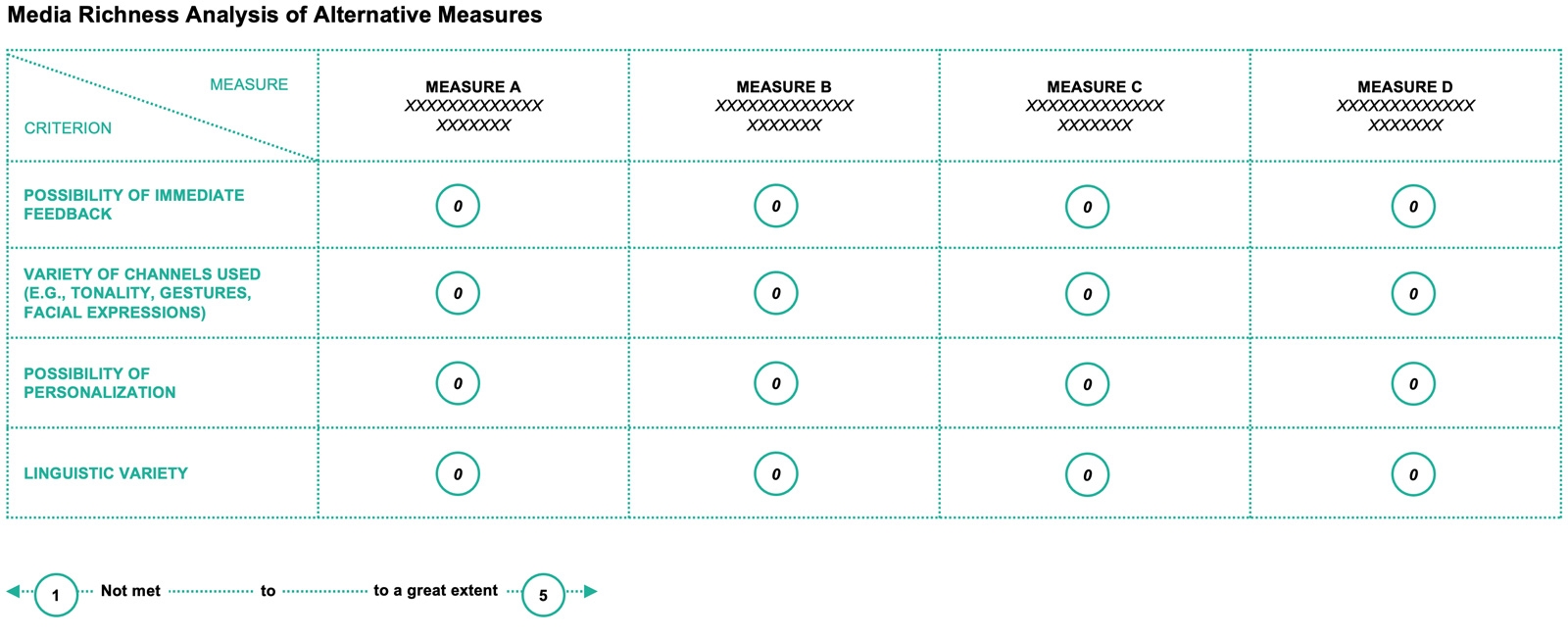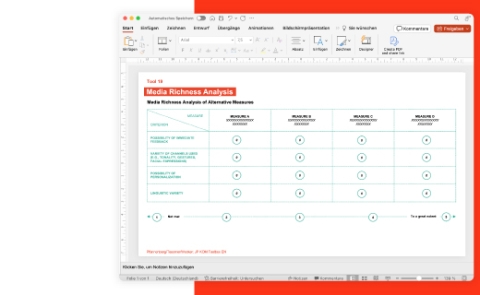Media Richness Analysis

Guiding question
Which media can be used for which communicative content/social interactions?
Objectives
- Assess the potential of media for coping with (communicative/social) complexity
- Assign the media to the communicative tasks
- Optimize the effect of the use of media
- Avoid misallocations
Implementation
The tool assesses the media richness of media – and thus their potential to reduce communicative and social complexity in communication – by scoring on a scale of 1 to 5 across four criteria:
- Possibility for immediate feedback in the communicative situation. Can participants give each other real-time, high-frequency (synchronous) feedback, such as in a conversation or a video conference? Or can the feedback only be time-delayed (asynchronous), as with mail traffic or letters?
- Variety of channels used. Is a single-channel medium used, such as e-mail, or do participants communicate via multiple channels, as in a videoconference (written and graphic, spoken language, image). Or are all five senses possibly involved in the communication and decide on the communication success, like at an event with catering?
- Possibility to personalize the address. Can the communication be adapted to the addressee or do all members of the stakeholder group receive exactly the same?
- Linguistic variety. Is "pure information" given in the typical language for this purpose, or are other language patterns also used, e.g., personal address in self-expression and relationship management (cf. Tool 36), up to and including storytelling (cf. Tool 53)?
Theory: Media Richness
The media richness theory makes statements about the relationship between the communication content and the medium used. The basic thesis is: The more complex – ambiguous, unreliably transmittable, and multi-layered – the content is, the richer the medium must be to reduce the ambiguity of communication in the social situation and thus enable successful communication.
In the understanding of Daft/Lengel (1986), on whose research the theory is based, media richness is realized in properties such as:
- Possibility for immediate feedback in the communicative situation. The possibility of synchronous feedback is obviously directly related to the channels used.
- Variety of channels used. Factors such as facial expressions, gestures, and tonality are particularly important for social matching in social interaction. It is now also known how, for example, olfactory perception of the other person influences communication and social interaction
- Possibility to personalize the address. In conversation, the constant mutual adaptation of communication to the situation and the needs of the other side takes place through mutual observation and the play of expectations. In contrast, this is not possible in a mass email, where personalization is at best achieved via the name in the address.
- Linguistic Variety. Linguistic diversity is partly driven by the communication process itself – the play of expectations and expectancies and their development through mutual feedback.
According to the theory, less rich media, such as mails, are suitable for simple arrangements and scheduling. But these low-rich media are prone to misunderstanding and irritation when dealing with more complex content. Rich media prevent this: Conversations or events are suitable for the clarification and social co-orientation and reconciliation of complex issues and claims to validity. This applies all the more to topics that require a high degree of collaboration, such as teamwork or creative processes in design thinking.
Media-richness theory is also one approach to explaining flaming: the accumulation of harsh speech in e-mails and social media to the point of insult. Obviously, the low richness of these media leads to the failure of mutual situational social control, such as occurs in a face-to-face conversation.
